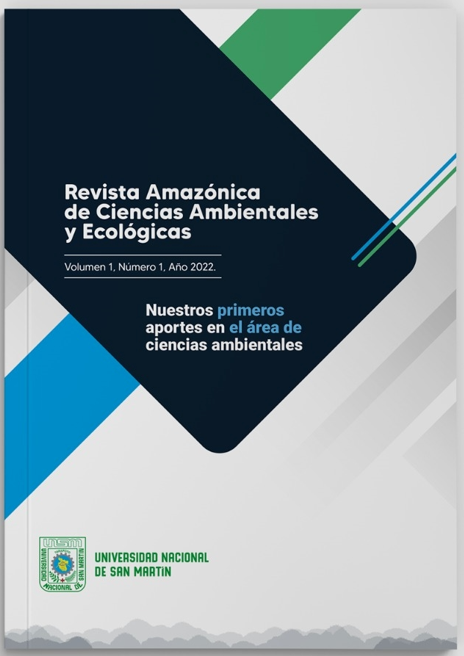Quantitative effect of climate change on the phenological calendar of flowering and fruiting of seven forest species in a forest established in the San Martín region
DOI:
https://doi.org/10.51252/reacae.v1i1.287Keywords:
pluvial precipitation, relative humidity, specie, temperatureAbstract
We seek to determine the quantitative effects of climate change on the phenological calendar of flowering and fruiting of seven forest species: Capirona, Shaina, Bolaina, Marupa, Teak, Eucalyptus and Pink cedar, during the 2013-2015 period. The evaluations comprised 35 individuals observed for a period of 24 months, using the methodology proposed by Fournier. We found that climate change has generated significant effects in the advancement of the phenological calendar of flowering and fruiting in the Calycophyllum spruceanum and Simarouba amara species, and in the delay in the Colubrina glandulosa and Guazuma crinita species; in addition, a great variability in the phenophases of the species of Tectona grandis and Eucalyptus globules. Due to their adaptation, acclimatization and habitat, they presented a complete phenological cycle, with the exception of Acrocarpus fraxinifolius. Flowering and fruiting are influenced by the variable temperature with a permissible range of 21.3 ºC to 33.3 ºC according to the maximum, minimum and average temperature of the established period, and with respect to the historical pattern 1981-2010 anomalies of 0.5 ° C were registered, 0.4 ° C, and 0.2 ° C, respectively. The quantitative statistical model of correlation, analysis of the Chi square distribution and the Coefficient of determination, found a weak to moderate positive association relationship
Downloads
References
Arteaga N., L. E., & Burbano N., J. E. (2018). Efectos del cambio climático: Una mirada al Campo. Revista de Ciencias Agrícolas, 35(2), 79-91. https://doi.org/10.22267/rcia.183502.93
Buitrago Guillen, M. E., Ospina Daza, L. A., & Narváez Solarte, W. (2018). Sistemas silvopastoriles: alternativa en la mitigación y adaptación de la producción bovina al cambio climático. Boletín Científico. Centro de Museos, 22(1), 31-42. https://revistasojs.ucaldas.edu.co/index.php/boletincientifico/article/view/2724
Chujutalli. (2009). Manejo Silvicultural de una Plantación en los Campos del I.S.T. “Nor Oriental de la Selva”. Instituto Superior Tecnológico “Nor Oriental de la Selva”.
Fournier, L. (1974). Un método cuantitativo para la medición de características fenológicas en árboles. Turrialba, 24(4), 422-423. https://www.scienceopen.com/document?vid=2242189e-658c-42f6-9204-35ab1c5b0fca
Fournier, L. A., & Di Stefano, J. F. (2004). Variaciones climáticas entre 1988 y 2001, y sus posibles efectos sobre la fenología de varias especies leñosas y el manejo de un cafetal con sombra en Ciudad Colón de Mora, Costa Rica. Agronomía Costarricense, 28(1). https://www.redalyc.org/pdf/436/43628110.pdf
García, S., & Panduro, M. (2008). Instalación de una Plantación con especies forestales en los campos de Instituto Superior Tecnológico “Nor Oriental de la Selva”. Instituto Superior Tecnológico “Nor Oriental de la Selva”.
Guisan, A., & Zimmermann, N. E. (2000). Predictive habitat distribution models in ecology. Ecological Modelling, 135(2-3), 147-186. https://doi.org/10.1016/S0304-3800(00)00354-9
Humboldt, F., & Bonpland, A.-J.-A. (1807). Essai sur la géographie des plantes (ed. 1807). A Paris : chez Fr. Schoell, libraire, rue des Maçons-Sorbonne, N.o 19 ; et a Tubingue : chez J. G. Cotta, libraire.
Intergovernmental Panel on Climate Change. (2007). Cuarto informe de evaluación climate Chaug 2007: The Physical Science Basic Alley, R.ET.AL. Cambridge University Press. UK.
Menzel, A., & Fabian, P. (1999). Growing season extended in Europe. Nature, 397(6721), 659-659. https://doi.org/10.1038/17709
Montenegro, G., & Ginocchio, R. (1999). La fenomorfologla y su expresión a través del crecimiento modular en las plantas leñosas perennes. Ecofisiología Vegetal y Conservación de Recursos Genéticos.
Pearson, K. (1900). X. On the criterion that a given system of deviations from the probable in the case of a correlated system of variables is such that it can be reasonably supposed to have arisen from random sampling. The London, Edinburgh, and Dublin Philosophical Magazine and Journal of Science, 50(302), 157-175. https://doi.org/10.1080/14786440009463897
Rosenzweig, C., & Casassa, G. (2007). Climate change 2007 Impacts adaptation and vulnerability contribution of working group II to the fourth assessment report of the intergovernmental panel on climate change. Cambridge University Press. UK.
Ruíz Rivera, N., & Galicia Sarmiento, L. (2016). La escala geográfica como concepto integrador en la comprensión de problemas socio-ambientales. Investigaciones Geográficas, 89, 137-153. https://doi.org/10.14350/rig.47515
Spano, D., Cesaraccio, C., Duce, P., & Snyder, R. L. (1999). Phenological stages of natural species and their use as climate indicators. International Journal of Biometeorology, 42(3), 124-133. https://doi.org/10.1007/s004840050095
Valdéz S., L. (2018). El cambio climático desde la perspectiva de la psicología ambiental. Acta Psicológica Peruana, 3(1), 177-202. http://revistas.autonoma.edu.pe/index.php/ACPP/article/view/130
Published
How to Cite
Issue
Section
License
Copyright (c) 2022 Williams Ramírez-Navarro, Alfredo Quinteros-García

This work is licensed under a Creative Commons Attribution 4.0 International License.
The authors retain their rights:
a. The authors retain their trademark and patent rights, as well as any process or procedure described in the article.
b. The authors retain the right to share, copy, distribute, execute and publicly communicate the article published in the Revista Amazónica de Ciencias Ambientales y Ecológicas (REACAE) (for example, place it in an institutional repository or publish it in a book), with an acknowledgment of its initial publication in the REACAE.
c. Authors retain the right to make a subsequent publication of their work, to use the article or any part of it (for example: a compilation of their works, notes for conferences, thesis, or for a book), provided that they indicate the source of publication (authors of the work, journal, volume, number and date).




